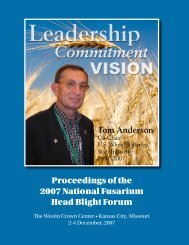Grain Sampling for DON Analysis - U.S. Wheat and Barley Scab ...
Grain Sampling for DON Analysis - U.S. Wheat and Barley Scab ...
Grain Sampling for DON Analysis - U.S. Wheat and Barley Scab ...
You also want an ePaper? Increase the reach of your titles
YUMPU automatically turns print PDFs into web optimized ePapers that Google loves.
<strong>Grain</strong> <strong>Sampling</strong> <strong>for</strong> <strong>DON</strong> <strong>Analysis</strong><br />
What is <strong>DON</strong>? Deoxnivalenol (<strong>DON</strong>), sometimes referred to as vomitoxin, is a mycotoxin<br />
that may be produced in wheat <strong>and</strong> barley grain infected by the Fusarium head blight (FHB<br />
or scab) fungus, Fusarium graminearum. The occurrence of FHB in the field does not<br />
automatically mean that <strong>DON</strong> is present in the grain, but a high level of infected kernels in<br />
the harvested grain means <strong>DON</strong> likely will be present. The US Food <strong>and</strong> Drug<br />
Administration (FDA) has established <strong>DON</strong> advisory levels to provide safe food <strong>and</strong> feed.<br />
In addition, the grain <strong>and</strong> malting industry may have more rigorous st<strong>and</strong>ards <strong>for</strong> <strong>DON</strong><br />
levels in their purchased grain.<br />
How is <strong>DON</strong> determined? <strong>DON</strong> is measured in grain via several laboratory methods,<br />
such as ELISA (Enzyme Linked Immunosorbent Assay), a FluoroQuant test, or gas<br />
chromatography-electron capture (GC-EC) <strong>and</strong> gas chromatography-mass spectrometry<br />
(GC-MS) analytical methods. <strong>Grain</strong> elevators, private labs, grain industries, <strong>and</strong> university<br />
testing labs may provide these tests. Regardless of methods used <strong>for</strong> analysis, the key to<br />
getting reliable <strong>and</strong> representative <strong>DON</strong> results lies with grain sampling. <strong>Sampling</strong> error<br />
can be a significant source of variation in <strong>DON</strong> levels.<br />
<strong>Grain</strong> sampling <strong>for</strong> <strong>DON</strong> determination begins in the field <strong>and</strong> continues at the elevator<br />
or mill.<br />
Field harvest effects on <strong>DON</strong> results: Producers may reduce the risk of high <strong>DON</strong> levels<br />
in the majority of their harvested grain by careful harvest methods. Often field margins or<br />
low levels of the field have been shown to have higher FHB severity <strong>and</strong> <strong>DON</strong> levels, in<br />
part due to possibly denser st<strong>and</strong>s along field margins (headl<strong>and</strong>s area) or because of higher<br />
prolonged humidities in low lying areas. Producers may chose to harvest these areas<br />
separately from the majority of their field, thus keeping more diseased grain separate from<br />
sounder grain, <strong>and</strong> reducing the risk of higher <strong>DON</strong> levels throughout the majority of<br />
harvested grain. In addition, producers may choose higher air speeds on their field<br />
combines, to prevent the low test weight, scabby kernels from being harvested. Postharvest<br />
grain cleaning also is an option <strong>for</strong> removing low test weight infected kernels,<br />
especially if gravity tables are available.<br />
<strong>Grain</strong> sampling at elevator or mill to get representative <strong>DON</strong>: To achieve a more<br />
accurate <strong>DON</strong> level estimate, it is critical that the collected grain sample be representative<br />
of an entire truckload or bin of grain. <strong>Grain</strong> <strong>and</strong> other particles, such as weed seeds,<br />
separate based on particle size <strong>and</strong> density as they flow <strong>and</strong> settle into a truck or bin.<br />
Smaller, denser material often may be is found the center of the truck or bin, <strong>and</strong> this is the<br />
material that is often higher in <strong>DON</strong> content.<br />
End-gate sampling: For sampling from an end gate grain stream, samples from<br />
the entire width <strong>and</strong> depth of the grain stream should be collected, not just the first <strong>and</strong> last<br />
portion of the load. A Pelican sampler or other sampling device aids in proper sample
collection <strong>and</strong> at least four samples of the entire grain stream should be collected at<br />
intervals to represent spatial different portions of the load.<br />
Probe sampling: The probe is the only sampling method approved by USDA-<br />
GIPSA (United States Dept. of Agriculture’s <strong>Grain</strong> Inspection Packers & Stockyards<br />
Administration) <strong>for</strong> stationary lots. Multiple (5-10) probe samples are generally<br />
recommended to obtain the best representative samples. GIPSA has specific<br />
recommendations <strong>for</strong> probe sampling of trucklots of barley <strong>and</strong> wheat <strong>for</strong> <strong>DON</strong>. Included<br />
in these recommendations are descriptions of sampling probes, sampling patterns, <strong>and</strong><br />
sample preparation, including appropriate cleaning, dividing <strong>and</strong> grinding of the samples.<br />
Probes should not be taken from the center or outer portions of a load because these areas<br />
do not reflect a cross section of the load. Also, GIPSA recommends a minimum 100 gram,<br />
cleaned sample be used <strong>for</strong> testing. GIPSA’s specific guidelines can be found at the link<br />
listed below. Other useful web-based links on grain sampling <strong>and</strong> <strong>DON</strong> also are provided.<br />
USDA-GIPSA<br />
Testing Trucklots of <strong>Barley</strong> <strong>and</strong> <strong>Wheat</strong> <strong>for</strong> Deoxynivalenol (<strong>DON</strong>)<br />
http://www.gipsa.usda.gov/GIPSA/documents/GIPSA_Documents/don.pdf<br />
NORTH DAKOTA STATE UNIVERSITY<br />
<strong>DON</strong> (Vomitoxin) in <strong>Wheat</strong> -- Basic Questions <strong>and</strong> Answers<br />
http://www.ag.ndsu.edu/pubs/plantsci/pests/pp1302w.htm<br />
OHIO STATE UNIVERSITY<br />
Where to Send <strong>Grain</strong> Samples <strong>for</strong> Mycotoxin <strong>Analysis</strong><br />
http://www.oardc.ohio-state.edu/ohiofieldcropdisease/wheat/mycotoxin%20text2.htm<br />
MICHIGAN STATE UNIVERSITY<br />
How to Sample <strong>Wheat</strong> to Accurately Determine Vomitoxin Levels<br />
http://web1.msue.msu.edu/imp/modab/26309701.html<br />
US WHEAT AND BARLEY SCAB INITIATIVE (USWBSI)<br />
Early Detection of Deoxynivalenol in <strong>Wheat</strong><br />
http://scabusa.org/pdfs/<strong>for</strong>um_01_proc_fstu.pdf














